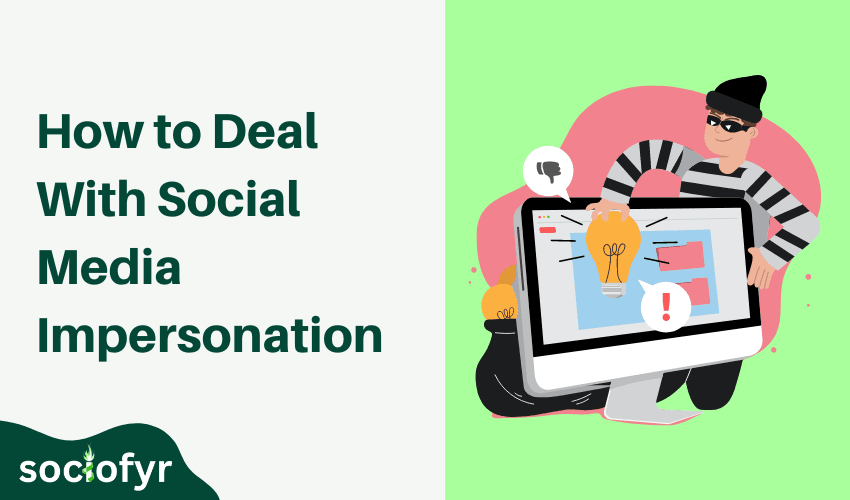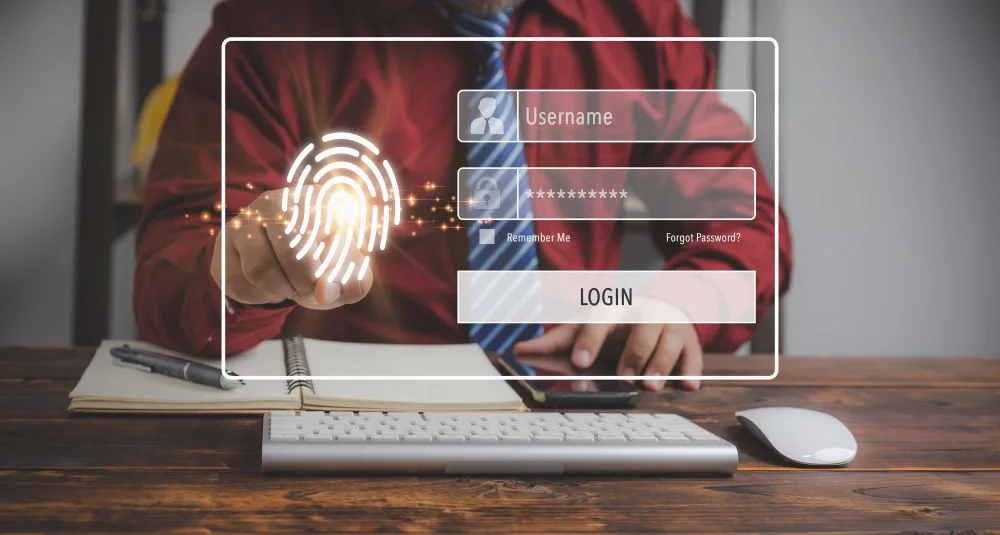How to Deal With Social Media Impersonation

Social media impersonation has emerged as a significant threat that has an equal impact on individuals and businesses. Every year, fraudsters adopt different techniques to scam people. The Federal Trade Commission (FTC) 2023 reported that scams involving social media platforms caused a $1.5 billion loss in 2023. This marks a notable rise from previous years.
The FBI published an Internet Crime Report in 2022, stating that a common type of executive impersonation, Business Email Compromise (BEC) attacks, cost businesses a $2.7 billion loss.
For businesses, impersonation is not just a loss of money but it also results in a loss of trust and reputation. In today’s digital era when most of the businesses tend to grow on social media for better reach, understanding how to manage impersonation on social media has become an essential part of business strategy for new and established brand owners.
In this guide, we will learn thoroughly when and how social media impersonation started, its types, how to manage if your brand has been hit with an impersonation attack. We will also help you to craft your future plans that avoid social impersonation naturally.
What is Social Media Impersonation
Brand or social media impersonation occurs when someone creates a fake profile or social media account using someone’s photos, name, and personal information without their consent. This is done by fraudsters for many reasons such as deceiving people for money or damaging someone’s reputation.
It can be done by making a new profile or hijacking an existing social media account. It can be used for identity theft and is used for many illegal purposes. However, the impersonating accounts are different from the fan pages of a particular brand or individual.
Key Differences Between Impersonation and Identity Theft

Although they may appear to be the same, there are slight differences between them. Let’s uncheck how they differ:
♦ Social Media Impersonation
- Creating fake profiles or accounts that impersonate or mimic legitimate individuals or organizations
- The purpose is to deceive and make people believe they are the real individual or brand.
- Common tactics involve using the same picture, details, and name
- The end goal is to spread misinformation, conduct scams, damage the reputation
- For example, fake brand page selling bogus products
♦ Identity Theft
- Theft and misuse of personal or financial information
- The purpose is to commit fraud or other crimes using the stolen identity details
- Common tactics involve accessing bank details, applying for loans, making purchases
- The end goal is financial gain by misuse of personal information
- For example, stealing credit card information to make unauthorized purchases
Purpose of Social Media Impersonation
Social media impersonation can be used for several purposes; here are two of the main purposes of social media impersonation
♦ Fraud or Scam
Impersonators can create fake accounts in the names of reputable organizations and firms and sell their faulty products. They can also pretend to be surveyors and ask for your personal information, money, or other resources. For example, they can pose as someone trusted and ask for money for donation purposes.
♦ Reputation Damage
Sometimes, damaging the reputation of an individual or a trusted company can benefit their competitors. So, social media impersonators can mimic their identities and post misleading content to damage people’s trust. This can be more damaging for public figures, businesses or individuals with significant online presence.
Common Types of Social Media Impersonation Attacks
♦ Employment Scams
The most common type of social media impersonation is reported in underdeveloped or developing countries. Scammers offer lucrative jobs with monthly commission and perform proper interviews to pose as real recruiters. In return, they ask for personal information, including bank details and credit cards for salary.
♦ Fake Account Scams
Impersonators create fake accounts that almost look like the originals with proper post grid setup and story highlight mimicking real individuals, especially celebrities, influences, or famous brands and companies. They interact with their already impressed followers and trick them into giving away their personal information. Later, they can use this information to blackmail them, asking for money.
♦ Fraudulent Transactions
Impersonators might call or text you, pretending to be someone trusted by your family or friends, and ask for emergency money. They can also convince victims to make transactions such as donate to fake charities or invest in fraudulent schemes.
♦ Phishing Scam
Phishing Scam involves making public social media profiles using famous companies and their employees and sending messages to the followers that might appear urgent or official, such as fake security alerts or promotional offers.
These messages often contain links to fraudulent websites that are designed to retrieve your personal details, login credentials, financial details, or other personal data. So always check URLs for legitimacy before clicking and use two-factor authentication on your accounts to avoid these cyber-attacks.
♦ Accounts Hijacking
Another type of social media impersonation is one in which impersonators do not mimic but hijack your existing social media account. This makes it easier to deceive people because people already have trust in that account, and it is easy to ask for personal details or do financial scams. Hijacked accounts can also be used to defame the individual or firm easily by posting irrelevant content and spreading malware.
♦ Relationship Scam
Impersonators build romantic relationships and use tactics often leading to convince victims to send money or personal details.
♦ Impersonating Someone as Minor You Know
A growing concern in social media fraud. Impersonating someone as a minor, you know, where they pretend to be a child or adolescent to exploit trust and manipulate others. Typically, impersonators create fake profiles using images and videos of kids and language that appeals to younger audiences.
This type of impersonation may be hard to detect because children are not aware of most of the online risks, making them susceptible to fraudulent activities.
How Impersonators Target Your Brand and Company

Impersonators use various fraudulent techniques to target your brand and customers. Learning how to manage impersonation in social media and their techniques is essential. Let’s uncheck some of the most common techniques used by them:
♦ Phishing Via Direct Messaging
Impersonators pretend to be one of the employees of your company and use phishing via direct messaging by sending faulty links. These links often lead to websites that are already attached to bots to fetch your personal data.
Or they can directly ask you for your passwords and credit card numbers, saying that there are errors occurring and that they want to secure your data. They often create an element of urgency, such as warnings about account security, prompting users to act quickly without realizing the danger.
♦ Fake Customer Support
This is an old tactic to fake customer support service and asking for personal details. But the fact even today, people get trapped in this impersonation technique. It is because they replicate the brand so well that they look original. They create bogus giveaway pages, deceiving the customers with promises of prizes and discounts.
For a giveaway or prize, they ask for personal details, and later, they use this information to impersonate them.
♦ Profile Cloning
This is the most effective technique used by impersonators because people tend to follow brands blindly, and they use this as a tool to fool them. Two types of people of brands are more prone to this impersonation technique:
➙ Brands with great physical presence but no online presence (no social media accounts or activity)
➙ Companies with a lot of social media handles and daily activities on social media
Why we say this because brands with a good customer base in the physical world but are not active on social media provide an opportunity for impersonators to create their social media profiles. They do not need to replicate even because people will automatically believe it’s the original brand page or profile.
Secondly, brands or companies with lots of social media activity are also prone to profile cloning as they are easier to replicate. People are already used to their great online visibility, so making a new profile and uploading content will not let them differentiate between the two.
Selection of Impersonating Social Media Network
With diversified social media networks, it provides room for impersonators to select the best social media channel for them. Impersonation on brands such as LinkedIn can involve targeting brand executives or employees to draw their fan base and trust.
Similarly, impersonation on Facebook is done through pages and groups. Threads and Instagram are used for profile cloning.
Impersonation Attacks on Celebrities
Celebrity impersonation attacks on social media are increasingly common impersonators using these tactics to confuse the millions of fans. One such example occurred two years back when Binance’s Chief Communication officer, Patrick Hillman was found trapped in an impersonation attack. Impersonators used his video from a social media appearance and made a deepfake from it. This deepfake was so realistic that scammers used it to commit financial fraud.
One similar incident occurred in 2023 when a deepfake featuring Tom Cruise was released on TikTok, confusing millions of users. It hit the internet so hard and became viral within some hours and raised concerns about how easily impersonation can misguide and damage a celebrity’s reputation.
In 2020, a social media impersonation scheme targeted many high profile celebrities, including Elon Musk, Bill Gates and Barack Obama. The scammers created fake Twitter accounts and cloned these celebrities’ profiles and posted tweets encouraging followers to send cryptocurrency to their wallets.
Red Flags to Spot Social Media Impersonation
Impersonating someone else on social media has become a powerful tactic for scammers, targeting individuals, brands, and celebrities.
♦ Unsolicited Messages from New Accounts
Be cautious if you receive a new message from unknown, newly created accounts or accounts you do not follow. In case you receive a message from an account you already follow that contains a request for money pe, personal data, or links to phishing data, make sure they are not hijacked. You can ask your friends following the same page if they also received the messages to understand the situation.
♦ Profile Discrepancies
Mismatched or incorrect profile information, such as slight variations in the username, bio, or contact details, can indicate a fraudulent account. Must look for the following points to identify a fake account:
➙ Slight misspellings of a brand or celebrity name
➙ Incorrect or missing contact details
➙ Low-quality improper profile images or logos
♦ Low Engagement
If an account poses as a public figure or a brand but has low user engagement, it is a warning sign. Impersonators often have a low number of followers and their post grid may not look like a legitimate account. They are often short spanned and do not build followers organically.
♦ Similar Accounts with Minor Differences
Another common tactic involves creating multiple profiles that resemble the original account but with minor changes. These accounts often have the same profile pictures and names but with minor changes or added characters.
♦ Unusual Posts or Requests
Impersonators may post content that is not usually published by the legitimate person or companies. Pay attention to posts promoting unusual offers or giveaways and directing followers to external websites, or making unrealistic promises.
Best Practices to Prevent Social Media Impersonation

♦ Verify Your Account
Many social media platforms have changed the verification processes of accounts after an increase in impersonation attempts. Now, make sure you have verified your social media account with the platform’s blue tick (Twitter/X, Facebook, Instagram). This will help followers identify official accounts and profiles.
Furthermore, you should encourage all the employees or particularly high-profile individuals in your firm to verify their accounts to mitigate any chance of impersonation.
♦ Enable Two Factor Authentication
Activate two-factor authentication for all your social media accounts to prevent unauthorized access. This adds an extra layer of security and prevents your account from being hijacked or used for illegal activities.
♦ Use Copyright and Trademark Protections
Register your company’s name, logo, and other identifying assets as trademarks, so you can more easily demand takedown if someone tries to impersonate your social media account.
♦ Communicate with Your Audience
If you are taking advanced steps to prevent impersonation, keep your audience informed about it. Alert them about any known impersonation threats and regularly remind them of your verified accounts and encourage them to report any fake accounts they came across.
♦ Respond Quickly
In case impersonation of your social media accounts occurs, immediately report to customer support of that social media network. Most platforms how clear guidelines on how to manage impersonation in social media, and a quick response can mitigate the chances of any financial as well as reputation loss.
♦ Review your Privacy Policy
Always keep a check and regularly keep updating your privacy policy to limit the access of illegal impersonators.
♦ Regulate Your Passwords Regularly
Another method to avoid impersonator’s hijacking attacks is to keep changing your passwords regularly. Because weak passwords or passwords linked with your companies or personal names provide the easiest way for impersonators to break the barrier and steal your data.
➙ Use a password manager to generate and store complex passwords
➙ Change your passwords, especially if there is a recent breach
♦ Limit Public Information Sharing
The more personal information you share publicly, the easier it becomes for impersonators to fraud you. Always be cautious about what you post online. Better to make your personal account separately and do not share sensitive information about you like your current location.
♦ Monitor Account Activity
Keep an eye on your account activities to detect any unusual happenings. This includes checking login locations, unauthorized devices, or changes in settings. To avoid better
➙ Setup notifications for unauthorized logins
➙ Routinely review account settings and limit permissions to third-party apps
A Self-Help Guide to Report Impersonation
While many social media platforms provide essential tools to protect against impersonators, they leave the task of identifying and reporting impersonating accounts to them. In this regard, the following points can help you check if there are any impersonators who are committing fraud in your name and how to report them.
If you have fallen victim to someone impersonating your identity online, it is crucial to know how to manage impersonation in social media effectively. While managing impersonation is critical, it is also important to recognize the legal risks of impersonating someone else on social media.
Search with Keywords
Put your brand name in the search bar and see if there are any other accounts running with this name. Additionally, also search long-tail keywords, including some misspelled words, as impersonators choose these names to avoid a ban. Once you have collected all the evidence, make a report with these profiles’ URLs, send them to social media support teams, and ask them to ban these accounts immediately.
Logo and Profile Picture Recognition
Some impersonators can use logos and profile pictures to deceive people. As you cannot directly check if someone’s using them, AI-powered tools help you in this regard. These tools automatically recognize images along with keyword monitoring to detect brand impersonation early.
How to Manage Impersonation in Social Media Automatically
It becomes difficult to manage multiple social media accounts and cope with the growing trend of impersonation. For busy individuals and business owners, there are plenty of automation tools to help you tackle these kinds of situations. Here are some tools that can help you stay.
♦ ZeroFOX
A comprehensive social media protection platform mainly designed for large scale businesses and brands but individuals can also benefit from its features. ZeroFOX automatically scans social media platforms for any accounts or profiles that might be impersonating someone else or a brand.
How to Use ZeroFOX?
ZeroFOX offers a simple and easy to use interface. Companies can simply integrate it with their social media security strategy platforms. It automatically monitors social media accounts for unauthorized use of logos, names, or images. Individuals can also set up alerts for their personal accounts, helping them detect if someone is trying to impersonate them.
♦ Social Mention
Although Social Mention is basically a social media tool that tracks mentions and conversations about your brand. However, it can also be handy in identifying impersonators by keeping tabs on how and where your identity is being discussed.
How to Use Social Mentions?
You can set up keywords related to your name, brand, or image, just like you make hashtags for your Instagram posts or reels. Add some misspelled keywords or extra characters to check if someone is trying to impersonate you differently. Social Mention will automatically notify you if someone is impersonating you or using your likeness.
What Social Media Platforms Are Doing Against Impersonation
As the social media impersonation issue grows, platforms are implementing several techniques to help users understand how to manage impersonation in social media and prevent it from occurring.
♦ Facial Recognition Technology
Some platforms, such as Facebook, use facial recognition technology to identify when someone uploads a photo or video that belongs to another user. This is preventing impersonators on some scale from using the real content to deceive others.
♦ Enhanced Privacy Controls
Social media platforms have now enhanced privacy controls that allow users to better protect their personal information. These settings can limit who can see your profile, send messages, or view your posts. Reducing access to personal details to everyone decreases the chances of your information being stolen.
With better privacy settings, users also learn how to manage impersonation in social media by limiting exposure to potential threats.
Conclusion
Social media impersonation is a growing concern that affects individuals, businesses, and public figures equally. The risks associated with someone impersonating someone else online range from personal embarrassment to financial fraud and reputation damage.
As the issue becomes widespread, learning how to manage impersonation in social media is essential for new and existing social media users. In this regard, social media platforms are continuously taking actions and improving their algorithms to reduce the risks of impersonation.
While platforms continue to improve their defense, users must take precautionary measures, regularly monitor their online presence, and take advantage of tools to report and stop social media impersonations.
Frequently Asked Questions
How to manage impersonation in social media?
If you find someone is impersonating you on social media, report these fake accounts using the platform’s reporting feature or by contacting the support service. Inform your friends, family, and followers to avoid interaction. Additionally, keep updating your passwords, privacy policy and enable 2 step verification on all accounts.
Are there any tools to manage social media impersonation?
Several tools such as ZeroFOX, Social Mention, and BrandYourself can help you to identify and report if someone is trying to impersonate you on social media.
Can social media platforms automatically detect impersonation?
Yes, social media platforms are continuously improving their algorithms to avoid social media impersonation. Platforms like Facebook, Instagram, Twitter, and LinkedIn are now using machine learning algorithms and facial recognition techniques to flag suspicious activities, such as duplicate profiles with the same image or names.
Why impersonating someone else on social media is illegal?
Impersonating someone else on social media is illegal because it can result in fraudulent activities, identity theft, and defamation. Impersonators can face actions, such as account suspension or even criminal charges depending on the nature of the offense.